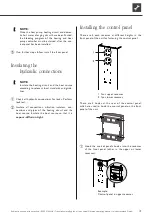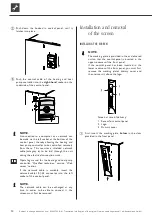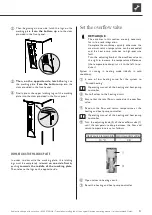
17
Subject to change without notice | 83050700fUK – Translation into English of the original German operating manual | ait-deutschland GmbH
CORROSION – AN UNDERESTIMATED PROBLEM
VDI 2035, Part II, deals with the problem of corrosion.
Softening the heating water can prove to be insufficient.
The pH value can significantly exceed the limit of 10. pH
values higher than 11 can set in, which even damage rub-
ber seals. The VDI 2035, Part 1 guidelines are fulfilled;
however, VDI 2035, Part 2 suggests a pH value between
8.2 and maximum 10.
If aluminium materials are used, which is the case in
many modern heating systems, a pH value of 8.5 must
not be exceeded! Because otherwise there is a threat of
corrosion – aluminium is attacked without the presence
of oxygen. Therefore, apart from softening the heating
fill and make-up water, the heating water should also be
appropriately conditioned. This is the only way to com-
ply with the VDI 2035 requirements and the recommen-
dations and installation instructions of the heat pump
manufacturer.
Part 2 of VDI 2035 also refers to the reduction in total
salt content (conductivity). The risk of corrosion is far
lower if deionised water is used than is the case if the
system is operated with salty, i.e. softened water.
Even if the water has been softened beforehand, it con-
tains dissolved, corrosive salts, which act as electrolytes
due to the use of different materials in the heating sys-
tem and therefore accelerate corrosion processes. This
can ultimately result in pitting.
ON THE SAFE SIDE WITH LOW-SALT OPERATION
The problems listed above do not occur at all with low-
salt operation, as the heating water contains neither
corrosive
salts such as sulphates, chlorides and nitrates nor alkalis-
ing sodium hydrogen carbonate. The corrosive proper-
ties of deionised water are very low and in addition, scale
cannot form in the boiler. This is the ideal approach for
closed heating circuits, in particular, because low oxygen
input into the heating circuit can also be tolerated.
In general, when the system is filled with deionised
water, the pH value sets itself within the ideal range due
to “self-alkalinisation”. If necessary, a pH value of 8.2
can be very easily alkalised by adding chemicals. In this
way, optimum protection of the entire heating system is
achieved.
MONITORING
Analytical recording and monitoring of the relevant
water values and the added active conditioning sub-
stances is of decisive importance. Therefore, they
should be monitored regularly using appropriate water
test equipment.
FLUSH AND FILL THE HEATING CIRCUIT AND
THE DOMESTIC HOT WATER TANK
Place a bleeder (vent) at the highest point of the
heating circuit in the heating water outlet (flow)…
If necessary, place a bleeder at the highest point
of the heating circuit in the heating water inlet
(return)…
Open unit, if closed…
“Transport to the installation location”, and
.
Flush and fill the unit via the filling and draining tap...
IMPORTANT
Do not exceed a pressure of 2.5 bar when flush-
ing the unit. The drain line of the heating circuit
safety valve must be closed before flushing and
filling.
















































